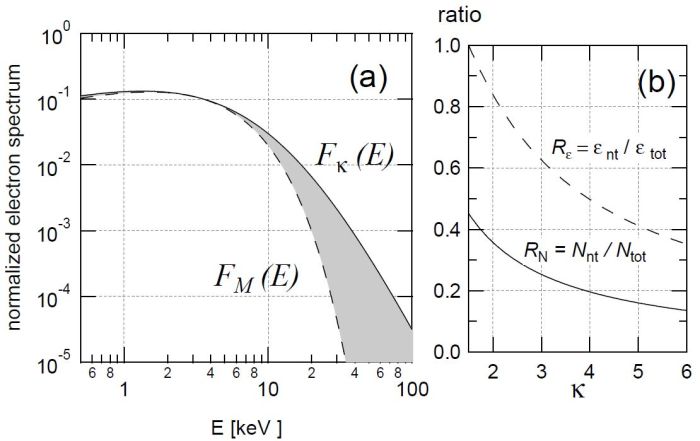Kappa Distribution
| Nugget | |
|---|---|
| Number: | 192 |
| 1st Author: | Mitsuo Oka |
| 2nd Author: | |
| Published: | 2013 January 21 |
| Next Nugget: | TBD |
| Previous Nugget: | Hard X-ray Spikes Observed by RHESSI |
Introduction
Solar flares produce high-energy, non-thermal electrons. To understand the origin of non-thermal electrons, it is important to know how many electrons are accelerated to non-thermal energies. We do this by measuring the X-ray photons emitted by the electrons during flares and generating energy spectra - histograms that show the energy distribution of the X-ray photons, which reflects the energy distribution of the electrons themselves. In general, a non-thermal tail is relatively flat in the energy spectrum and appears in a form of power-law. It extends from an intense and steep thermal component (Maxwellian). However, the power-law representation of the non-thermal tail requires a lower-energy cutoff in the spectrum, and the estimates of the non-thermal fractions of electron number/energy densities can be sensitive to this cutoff energy.
With this in mind, we revisited an ‘above-the-loop’ coronal X-ray source observed by RHESSI on 2007 December 31 and showed that the so-called kappa distribution can also be used to represent the energy spectrum. Because the kappa distribution has a Maxwellian-like core connected smoothly to the high-energy power-law tail, the emission measure and temperature of the instantaneous electrons can be derived without assuming the cutoff energy. Furthermore, the non-thermal fractions of electron number/energy densities can be uniquely estimated because they are functions of the power-law index only
The Kappa Distribution
The kappa distribution function was first introduced in 1967 as an empirical model to represent non-thermal electrons in the Earth's magnetosphere [1]. More recently, Jana Kašparová and Marian Karlický have applied the kappa distribution for solar flare analysis [2]. See the Nugget Fast electrons relaxing for further background information about the kappa distribution.
As illustrated in Figure 1 left, the kappa distribution is a single function with properties of both Maxwellian (in the lower energy range) and power-law (in the higher energy range). The difference between the kappa distribution and the adjusted Maxwellian (the shaded region in Figure 1) can be regarded as non-thermal. The fraction of the non-thermal particles (shaded region) is, in fact, a function of the power-law index (or "kappa") as shown in Figure 1 right). Therefore, we only need to find the power-index from spectral analysis in order to estimate how much fraction of electrons in a hard X-ray source was non-thermal. We do not need to assume a low-energy cutoff or a source volume, which are often defined rather arbitrarily.
